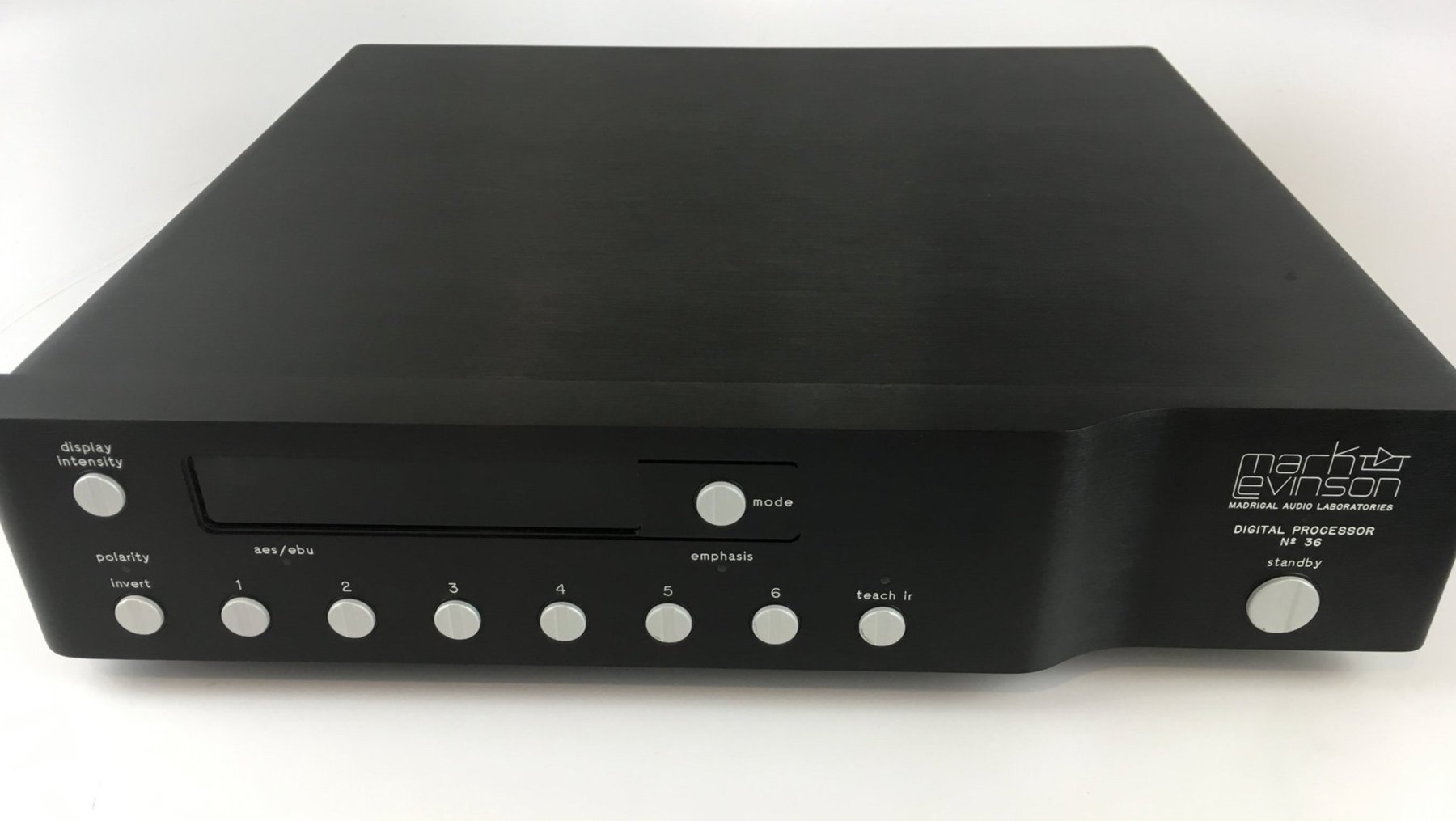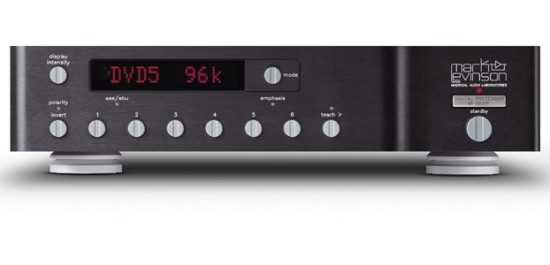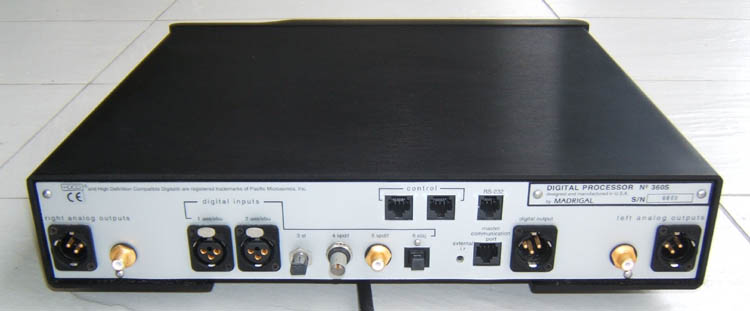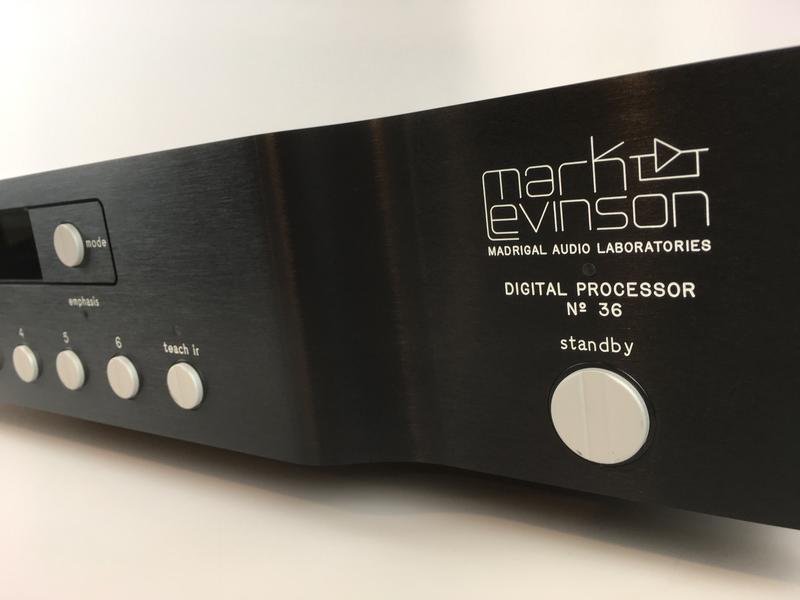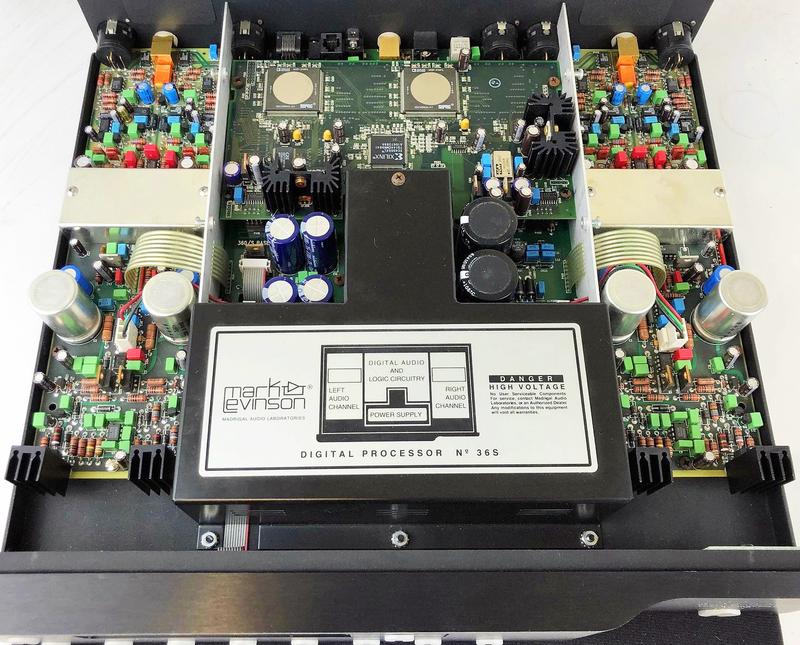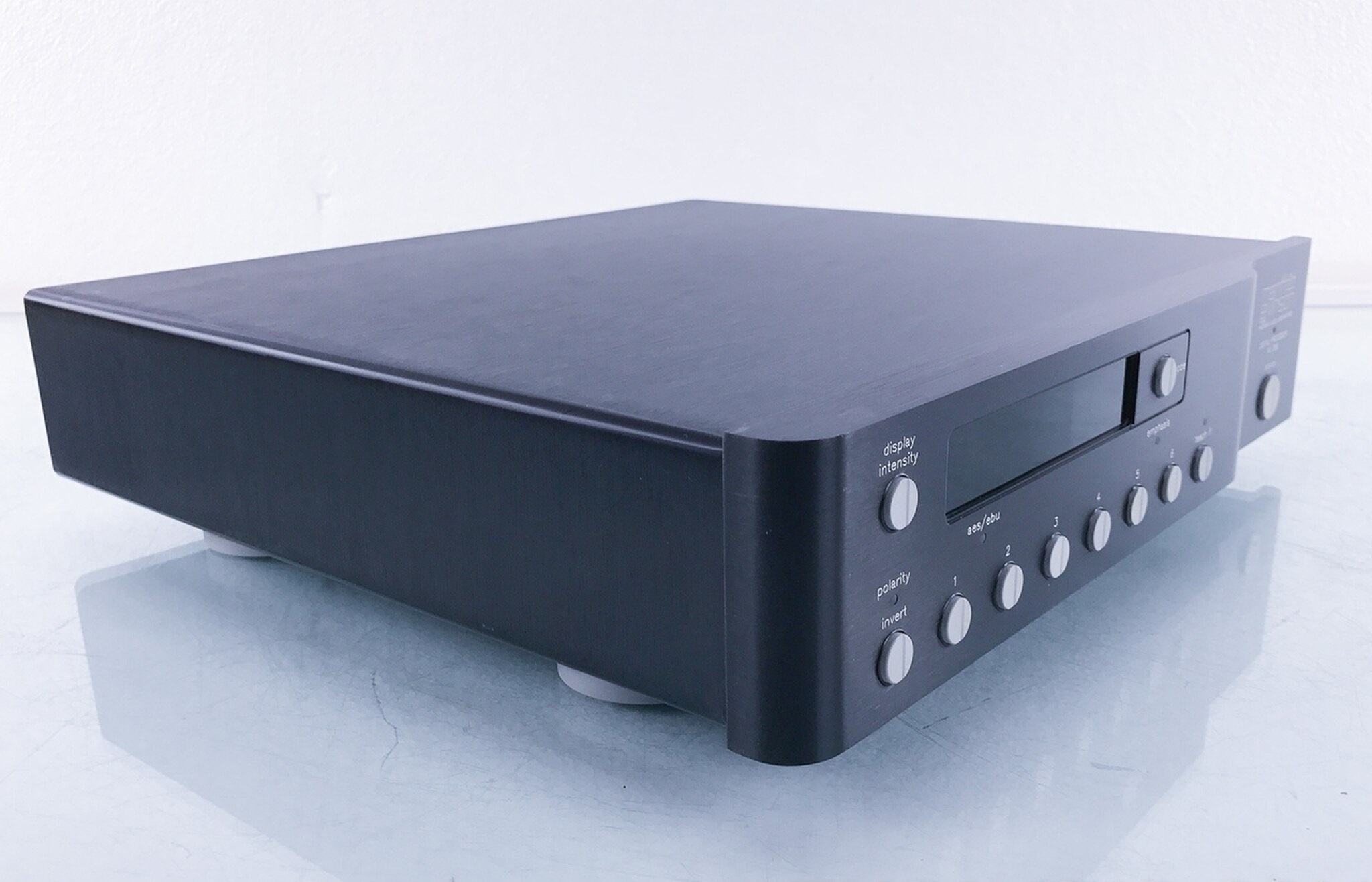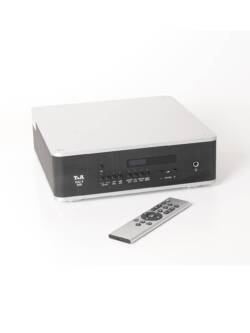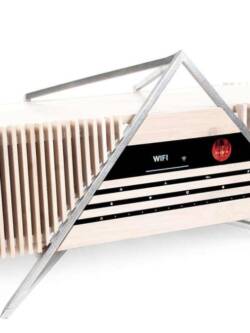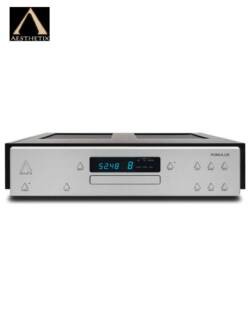Mark Levinson No.36 D/A converter
Original price was: R102,000.00.R18,000.00Current price is: R18,000.00.
Conclusions
The 37/36S is far less expensive than Levinson’s 31.5/30.5 combination, and in my judgment only those who simply like to spend lots of money would now choose the flagship pair—particularly with DVD for audio (which will require all new replay equipment) somewhere in the visible but still slightly fuzzy future. But CD is here today, and no CD playback device I know of will do the job better than the Levinson No.37 and No.36S.
Digital processor with HDCD decoding.
Inputs: two AES/EBU on XLRs, two S/PDIF coaxial (one RCA, one BNC), one ST optical, one TosLink optical.
Outputs: L/R balanced (XLR) and unbalanced (RCA) analog out. Digital out. Also one RJ-45 communications port (see text) and IR repeater port.
Frequency response: 10Hz–20kHz, +0, –0.2dB.
Dynamic range: 98dB (or better). S/N ratio: 105dB. Channel separation: >110dB. FIFO jitter: <20 picoseconds, uncorrelated. Output impedance: <6 ohms.
Dimensions: 15.75″ W × 14.3″ D × 3.75″ H.
Weight: 35lb. Serial number of unit reviewed: 1080.
Price: $3995
Description
When Madrigal introduced their Mark Levinson No.30—now the No.30.5—its price put it out of reach of any but the most affluent or debt-tolerant audiophiles. Add their No.31 transport, and you have a terrific combination which, unfortunately, turns up mostly in homes with four-car garages and security gates. And when the less-expensive No.35 was introduced, we were still talking champagne and Brie.
Now, however, with the introduction of the No.36 (and the companion No.37 transport), Madrigal has a CD playback combination available to the merely terminally obsessed among us. You can, of course, reduce your outlay more—a lot more—and still get quality digital replay. But if the you want your less-pricey thoroughbreds to come from the Madrigal stable, they will bear the name “Proceed,” not “Mark Levinson.”
Features & design
With inputs for every popular type of digital connection, the No.36 is ready for use with any transport or other digital source. The selected input signal fades in slowly to prevent extraneous switching noise. A front-panel LED display indicates the status of the selected input. The No.36 also may be programmed to display an appropriate name for that source—CD, DAT, DCC, or what-have-you. Other front-panel functions are Phase, Teach, and Mode. Phase, as you might expect, inverts the phase (polarity) of both channels. Teach allows the No.36 to program an outboard learning remote to control its functions (no remote is provided with the No.36, but the remotes furnished with other Madrigal products are suitable). And Mode selects or turns off the digital output and serves as a control switch during processor setup (naming the inputs).
In addition to its inputs, and balanced and unbalanced outputs, a rear port labeled “Master Communications Port” allows the No.36 to be linked with other 30-series components such as the No.37 and ’31 transports, No.38 and ’38s preamplifiers, and No.33-series power amplifiers, further expanding functional flexibility.
One of the HDCD specifications calls for some form of level control to compensate for the 6dB difference in peak output level between conventional CDs and decoded HDCDs. The No.36 may be set up to do this automatically (Auto mode), in which case it drops the level of standard CDs by 6dB in the digital domain to match the average perceived level of HDCDs. In its Manual mode, it feeds the unaltered signal to the analog outputs, meaning that you must boost the preamplifier level by 6dB. Madrigal strongly prefers the latter, analog-domain level-change as the most sonically transparent.
If you use the No.36 with the most recent versions of the No.38 or 38S preamplifier, the communications link referred to in the preceding paragraph will automatically trigger this level change in the preamp when the No.36 senses an HDCD. In my case, since I used a preamp from a different manufacturer, I used the manual mode on the No.36 and made the level change myself at the preamp. (Incidentally, the No.36 is delivered in the Auto mode—with the level change made digitally and internally—because of HDCD requirements. This can be easily changed to Manual mode by the user.)
Madrigal makes much of the fact that the No.36 uses the new Pacific Microsonics PMD100 HDCD, 24-bit throughput, 8x-oversampling HDCD decoder/digital filter chip, which is said to be inherently superior, sonically, to previous digital filters even when used with conventional CDs. The overall resolution of the No.36 is limited to 20 bits by its D/A converters, two per channel operating in a balanced configuration. (We should never forget, with manufacturers throwing references to 20- and 24-bit resolution around with abandon, that higher-bit converters can never recover more than 16 bits from CDs—which are inherently limited to that resolution unless some kind of noise-shaping/redithering has been used in the mastering process. They simply make it more likely that we’ll get the full benefit of those 16 bits).
The No.36 also makes use of something called a “smart” FIFO (First In, First Out) buffer to minimize jitter. FIFOs are basically a way of re-clocking the incoming data with high precision, minimizing jitter which may be inherent in the incoming signal, and are not unusual in high-end D/A converters. But if the FIFO is too small, the buffer can either overflow with a subsequent loss of data, or be underfilled with a resultant need for additional error correction. If the buffer is large, there may be an unacceptable time delay (okay for audio but unacceptable with the audio signals on a laserdisc). With the No.36’s “smart” FIFO, the data release rate from the buffer is controlled by software that tracks the signal’s long-term data rate. The amount of data in the buffer memory will therefore never approach the full or empty states. As the output data clock can be made to be of very high stability and accuracy, any time variations in the received data clock—jitter—are simply ignored. Madrigal claims less than 20 picoseconds of jitter for the No.36.
This “smart” FIFO operates at the 44.1kHz sampling rate of CDs and laserdiscs and the 48kHz sampling rate of DATs. Though the No.36 will lock onto and decode the 32kHz sampling frequency proposed for digital satellite transmission—the latter little used and of no real concern in any event for high-end reproduction—the FIFO buffer is not functional at this rate.
Elsewhere, the No.36 shunts unselected digital inputs to ground to minimize interference. The internal circuitry is also fully balanced in both analog and digital (unbalanced digital inputs are converted to balanced before any processing is performed).
Sound
When I first put the Mark Levinson No.36 in my system, the Levinson No.35 D/A converter had been a long-term resident there. My initial impressions were that the No.35 was a little more open and sparkling on top—though those who tend not to like this quality may refer to it as “crispness.” But I had the same impression of the No.35 when I compared it with the original No.30 (Vol.16 No.11), so the No.36 was certainly in good company.
Most of my listening to the No.36 was done in its unbalanced mode. Direct comparisons between unbalanced and balanced modes in my system resulted in no significant differences (footnote 1). If I thought I heard anything, it was perhaps—just perhaps—a slightly more full-bodied sound in the unbalanced configuration. But it was a very elusive thing. Similarly, I used the coaxial digital input (RCA) for most of the auditioning. The differences between coaxial and ST optical were subtle and about what I’ve observed in the past. The coaxial—with the Kimber digital cables—was slightly more immediate and sparkling, the ST a little softer and sweeter.
In any mode, the longer I listened to the No.36, the more I liked it. When the No.35 went back to the manufacturer, I had some initial separation pangs, but they lasted about two days. The No.36 picked up the slack without missing a beat. I’ve used it not only in the system listed above, but also as the primary signal source in every review I’ve done in the past several months—both for Stereophile and for the listening-room portions of my reviews for the Stereophile Guide to Home Theater. It has not been a limiting factor in any of these reviews.
How do I describe the sound of the No.36 without describing the sounds of the components with which I used it? Only with great difficulty. The bass was deep and powerful through the Energy Veritas loudspeakers, full-bodied and extended through the KEF Reference 107/2s, and tight and punchy with the Thiel CS7s. From the solid bottom-end whack of the drums on Däfos (Reference RR-12 CD) and the bite of Dean Peer’s bass on Travelogue (Fahrenheit FR2451), to the low-end extension of the organ on Jean Guillou’s organ transcription of Mussorgsky’s Pictures at an Exhibition (Dorian DOR-90117), I found nothing to criticize. And if the top end of the No.36 had seemed a bit softer and sweeter in my initial exposure to it, the crisper-sounding No.35 was now just a memory: The No.36 revealed itself to have all the subtlety and detail I could hope for, while never sounding aggressive or harsh (except on the worst recordings).
But as with the frequency extremes, the sound of the No.36 through the midrange—including soundstaging and depth—appeared to be pretty much that of the rest of the system. It never imposed anything on the sound that I could point to and say “Ah-ha—that No.36 sound, again.” It simply did not call attention to itself.
High Definition Compatible Digital
As to HDCD, the performance of the No.36 remained top-class. Pop an HDCD into the transport, and the letters “HDCD” light up the No.36’s LED display screen. But color me undecided when it comes to HDCD vs standard CD. To date, there’s simply not enough material available in both formats (make that almost none) to make a really intelligent comparison. Sure, the HDCD recordings I’ve heard have been uniformly terrific in sound. But they’ve been excellent with and without decoding. Comparisons between their undecoded or decoded playback are not only invalid—because the coding results in subtle changes to the sound of an undecoded disc over that which might be expected from a conventionally mastered one—but also nearly impossible to make. You can’t shut off the HDCD processing in any HDCD decoder I know of, and comparing the modes using two processors—one HDCD, the other not—requires that the processors be otherwise identical: an impossible condition to meet.
Will HDCD catch on? A lot depends on what happens over the next year in the development of DVD, which promises a new, high-resolution format which might just revolutionize audio software. But it’s not available now, and HDCD is, if only in limited supply. All I can say is, when I switch from a cross-section of my best-sounding standard CDs to the small population of HDCDs now in existence—and given that I’m not talking about identical program material, but only general overall impressions—the clouds do not part, and the sun does not emerge to cast life-giving light on the fertile plains. When we get our hands on an HDCD encoder/ADC, so we can compare an original source to an HDCD recording of it—and perhaps in comparison with a first-rate conventional digital transfer of the same material—then we’ll talk.
Comparisons: Theta, Spectral, Sonic frontiers
Though it’s hard to pin down a specific level of performance with any given component and state that this is the point at which noticeable improvements in sound quality come only with precipitous increases in cost, the No.36 is as good a point as any. Though some will set that point much lower, I think I can say with assurance that the No.36 is definitely on that part of the curve beyond which incremental improvements come at a stiff price.
The only way to be sure, of course, is to compare the No.36 directly with a variety of other processors. With the Denon transport’s two coaxial digital outputs and the Rowland preamp’s precise and storable input level settings (the No.38 and 38s also have these capabilities), I was uniquely positioned to make these comparisons. Material could be played back and compared long-form, or instantly switched at matched levels. The latter capability required no extraneous equipment beyond the basic system itself. It was not a blind comparison, but was otherwise tightly controlled.
I compared the No.36 directly with the Theta DS Pro Basic III, the Sonic Frontiers SFD-2 Mk.II, and the Spectral SDR-2000 Professional D/A converters. Except for the Sonic Frontiers, which I auditioned in both its balanced and unbalanced modes, these comparisons used unbalanced connections. The digital feed was again the Denon.
First up, the Theta DS-Pro Basic III, a processor costing approximately half as much as the No.36. How did it differ? First, it’s fair to say that the Theta is a superb D/A in its own right, with good detailing, depth, and a lack of any irritating qualities—nothing artificial or off-putting about the sound of this converter. If I were shopping in this price range, I’d put the Pro Basic III high on my list of candidates to audition.
What, then, do you buy with the No.36 that you don’t get in the Theta? The No.36 had a quality of focus—call it clarity, transparency, inner detail—which the Theta cannot quite match. The soundstage was just a little less tightly defined with the Theta; multiple sources within the stage had less space between them. Solo voices and instruments were just a little more “there” on the Levinson. At the top end, the No.36 had more air and is more open. The difference isn’t mind-bending or even close to it, but it’s audible. And while I heard no inherent difference in depth between the two units, this added openness at the top added more space to the sound of the No.36; ambience, in particular, was more convincingly rendered.
At the bottom, however, it was a different story. As I went back and forth between the two processors, I initially heard no notable differences. But with continued listening, the Theta began to pull ahead. Though both processors were comparable in extension, the Theta sounded tighter and more detailed. The difference, again, was not enough to have me dancing in the streets, but I have to give the Theta the nod in its portrayal of the bottom octaves.
Next up: the Spectral SDR-2000 Professional HDCD D/A processor. RH salivated over this processor in Vol.18 No.5, and this was my first chance to hear it in my system. He did not exaggerate. It is clearly a Class A processor; it may even be the best processor in Class A, though I haven’t had the opportunity to compare it directly with the Mark Levinson No.30.5, which isn’t exactly chopped liver. [When I did this comparison, I found the Spectral to edge ahead in sheer coherence of its soundstage presentation, though its HF balance sounded a little too tilted-up in the context of my system.—John Atkinson.]
At first I found the differences between the SDR-2000 and the No.36 to be subtle—less notable than the differences between the No.36 and the Theta, above. Shortly, however, two primary differences crystallized. First, there was an increase in high-frequency air with the Spectral, combined with a boost in clarity and fine detail. This came without any of the corresponding edginess or roughness that often ride along with enhanced definition. (RH’s review measurements indicated a very small top-end rise in the Spectral’s frequency response which might account for this, though at +0.3dB at 20kHz, it doesn’t seem terribly significant—and I can’t hear 20kHz in any event.) And second, the Spectral was leaner through the upper bass and lower midrange. Riding on the coattails of these primary differences was an increase in soundstage precision, in lateral focus and depth. This improvement struck me as a result of the tonal changes, not an independent enhancement.
After a period of familiarity it was hard not to appreciate what the Spectral did for the sound of CDs, from the subtle percussive details on Mokave’s Afrique (AudioQuest AQ-CD1024) and The All Star Percussion II (Golden String GSCD 013), to Branford Marsalis’s ethereal saxophone on the soundtrack from Sneakers (Columbia CK 53146), to the separation of vocalists on recordings as dissimilar as the King’s Singers’ Good Vibrations (BMG Classics 60938-2), and Postcards (Reference RR-61CD).
Stated this way, these differences sound dramatic. They weren’t. The more I listened, the more obvious they became—and the more I agreed with RH’s conclusions. But the No.36 was very close. It was just a bit soft-sounding next to the Spectral. In one respect, however, I did prefer the No.36. Its slightly greater warmth sounded more natural with the human voice. The Spectral may have been a hair better defined at the very bottom end of the spectrum, but I wouldn’t base any purchase decision on the bass differences between these two excellent processors.
Which would I buy? If money were no object, the Spectral. The more I listened to it, the better I liked it. But at more than twice the price of the No.36, it had better be better. The fact that the differences are there will be of significance to those with the resources to take advantage of them. But I’d certainly be more than happy living with the No.36. The important point is not how good the Spectral is (and it is good), but rather just how close the No.36 is for half the price.
At $5295, the Sonic Frontiers SFD-2 Mk.II is somewhat more expensive than the No.36, but of the three processors compared here, it’s closest in price and a logical choice for a face-off. Again, the match was a close one, but not without noticeable differences. The Sonic Frontiers had a slightly more powerful low end, but the No.36 was noticeably tighter and better-defined in this region. The fuller bottom gave the Sonic Frontiers an appealing warmth; next to the No.36, it was richer and fuller on vocals—the one area where I definitely preferred it.
In the upper range, the No.36 had a more subtle, airy treble. The difference didn’t jump out and grab me, but percussion and other instruments with strong high-frequency overtones were more finely shaded on the Levinson. On the other hand, through the low and mid-treble, the Sonic Frontiers was more vivid, more “there.” I never found it to be unnaturally bright in this region, though here the differences with the No.36 were most obvious. More often than not the Frontiers added a subtle but effective presence to the sound. There were few, if any, differences in depth and soundstaging—but to the extent that there were, I attribute them primarily to this small spectral shift.
When I switched to the balanced mode on the Sonic Frontiers, the sonic differences between it and the No.36 became even more subtle. But the contrasts were noted in the same areas, and I would not significantly change my observations.
On balance, I have a tough time declaring a preference between the Sonic Frontiers and the Levinson processors. I liked the good old “palpable presence” of the SF, and the top- and bottom-end detail and definition of the No.36. I can’t imagine anyone being unhappy with either, but of course definite preferences will develop depending on the individual listener and the system. If they fit your budget, you should definitely hear, and consider, both.
Conclusions
What can I say? Run out and buy the No.36? That would not be bad advice if you have the price of admission. It certainly must be heard, even if only to hear what’s possible in today’s best D/A converters. Make no mistake: the No.36 can compete in that company (footnote 2).


